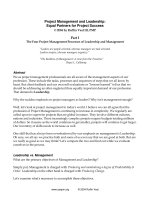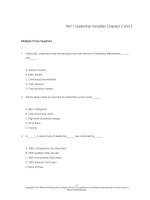Lecture Art of Leadership and Motivation - Lecture 23
Bạn đang xem bản rút gọn của tài liệu. Xem và tải ngay bản đầy đủ của tài liệu tại đây (1.67 MB, 28 trang )
Art of Leadership & Motivation
HRM – 760
Lecture 23
FACILITATOR
Prof. Dr. Mohammad Majid Mahmood
Driving Employee
Motivation
2
What will you need to do to achieve your 5
10 year`s vision?
What’s a must?
What’s useful?
What’s good, but not vital
3
It refers to the set of forces that cause
people to behave in certain ways
It is the inner feeling which energizes a
person to work more
The emotions or desires of a person
prompt him for doing a particular work
4
◦Individual forces that account for the direction,
level, and persistence of a person’s effort
expended at work.
Direction an individual’s choice when
presented with a number of possible alternatives.
Level the amount of effort a person puts forth.
Persistence the length of time a person sticks
with a given action.
5
WHAT MOTIVATES PEOPLE
• Achievement
• Responsibility
• Recognition
• Recognize achievements through
programs
that
showcase
performers.
• Feedback
• Learning and
growth
6
WHAT MOTIVATES PEOPLE
• Achievement
• Responsibility
• Recognition
• Feedback
• Learning and
growth
• Have volunteer programs and
other programs that enable
employees to showcase their
responsibility towards each other
and the society at large.
7
WHAT MOTIVATES PEOPLE
• Achievement
• Responsibility
• Recognition
• Feedback
• Learning and
growth
• Recognize winners through awards
like Service Quality Awards, Best
Operations Awards, Best Trainer
Awards, etc.
8
WHAT MOTIVATES PEOPLE
• Achievement
• Responsibility
• Recognition
• Feedback
• Learning and
growth
• Follow a system of feedback and
performance appraisal i.e the 360o
system in which both the boss and
subordinate participate.
9
WHAT MOTIVATES PEOPLE
• Achievement
• Responsibility
• Recognition
• Feedback
• Learning and
growth
• Give a lot of importance to
training and development and have
various training academies to cater
to various sections of employees.
• Analyze training needs to
recognize competency gaps and
impart
knowledge
through
customized training programs.
10
The Equity Theory was first discussed in
early 1960's by J. S. Adams.
It was a practical explanation for why
employees perform the way they do.
An employee compares his/her job’s inputsoutput ratio with that of relevant others and
then corrects any inequity.
Employees are motivated when their
perceived inputs equal outputs
11
Herzberg conducted a motivational study on 200
accountants and engineers
There are certain factors that tend to be
consistently related to job satisfaction
(Motivational factor) & on the other hand there are
certain factors which are consistently related to
job dissatisfaction (Hygiene factor).
12
13
He developed 2 theories : Theory X & Y
Theory X workers could be described as:
Individuals who dislike work and avoid it.
Individuals who lack ambition, dislike responsibility
Individual who desire security
Theory Y could be described as:
Consider effort at work as just like rest or play
They don’t dislike work.
Individuals who seek responsibility
14
15
Maslow’s Needs Theory
Self
Actualization
Esteem
Social
Safety
Physiological
16
Mclelland’s Motivational Needs Theory
ACHIEVEMENT AFFILIATION
POWER
17
Specific Difficult
Goals
Goals
Increase Performance
Higher Performance
18
19
Pakis tan`s Wo me n Cric ke t Te am
S uc c e s s
20
21
22
23
24
Increases
Increases
Effort
Effort
Improves
Improves
Focus
Focus
Drives
Drives
Creativity
Creativity
Aids
Aids
Retention
Retention
Because it…
Enhances
Enhances
Persistence
Persistence
25









